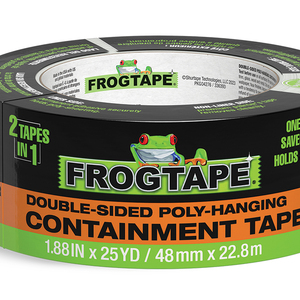Paintbrush Cleanup
This use of centrifugal force is especially effective for smaller brushes.

This tip works especially well for cleaning small brushes. Run an oversize screw into the paintbrush at approximately its center of gravity. Then tighten the point of the screw into the chuck of your drill/driver. Now dip it in some thinner, and spin it in a laundry sink or 5-gal. bucket. Repeat this a few times to fully clean the brush.
— Ray Berntsen, Seattle
Edited and Illustrated by Charles Miller
From Fine Homebuilding #268






























View Comments
I just don't know about this. An actual brush / roller spinner would be a lot safer and not a messy. Safety - if you have used oil base paint and cleaned in thinner make sure you have on some safety glasses. And hang on to your drill. If your off a little on center - going to be a ride.
Is the cost of a spinner (made for spinning) worth the damage to a good brush by installing a screw in the brush? The hole in the brush now allows water or cleaner into the wood handle.
I'll stick to my roller / brush spinner for cleaning out the head.
Gotta agree w/ Jeff- too much hassle for too little benefit, especially when there are roller/brush spinners commercially available. Granted this method spins brushes the "right" direction- a spinner makes them look like a kid with a bad haircut- but I've never found it to do any damage.
I volunteer w/ Habitat for Humanity sometimes & after a paint party, we have a couple dozen brushes to clean. Does anyone know of a production method for cleaning brushes?
BobboMax - I use to teach the Home Maintenance classes for Austin Habitat. Part of the class discussed painting, but after being on site and watching the "Paint Parties" all I can say is a cleaning party is also needed.
I would think soapy water, wire brush / brush comb, spinner and constant changing the water. Of course that does not fix the brushes with deep down hard paint in the brush. Only a good brush cleaner and time will correct that.
I guess that is why Habitat does not have very good brushes.
I happen to Agree with the Other Comments! Any Brush used in Any Job needs Cleaned Well after Every Use! I've never Painted for Habitat but Some of the Painters Working On any Project Should "Teach" the Amateurs the Correct Way to Clean Brushes, I'm Sure those People "Helping Out" would Appreciate that Instruction quite a Bit!
As a retired high school stagecraft teacher I can tell you some people don't wan't to learn to do it right. I bought cheep brushes for the students and kept my Purdeys locked away.
It seems to me that the less water or thinner used to get paint out of a brush is for the better. That is what I really like about these spin methods.
I like this particular idea for the reason that the centrifugal force is parallel to the bristles. With the commercially available spinners, the force direction is perpendicular to the bristles. Maybe that’s not significant, it just seems better if the force is parallel.
I drilled diameter 6 mm through a brush and put in an M6 x 60 mm hex head screw. To make it easier and quicker to put in and take out, I used a big plastic M6 nut from an old lawnmower. (I doubt if I want to paint with the screw in the brush.)
I needed to hold the drill with two hands to keep from whacking the bucket. What I didn’t need was anything to keep my hands from getting sprayed – the water/paint shot straight out against the sides of the bucket.